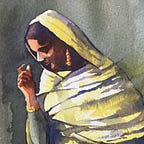The Crow in Mom’s Garden
I’ve made friends with a crow.
Every few days, I take left-over corner slices of bread and chop them up into small cubes. I take that out to the garden and drop the cubes into a clay bowl that I’ve placed for the birds. There’s a bowl of water as well that’s usually almost dry, or full of rotted bread that the crows have dropped into it. It invariably stinks, and the liquid in it is sometimes green, slimy. I have to remember to refill it more often, but I know I won’t.
The fresh water and bread crumbs are a ritual from back when Mom was still here. I’d cut the crusts off her toast for breakfast. I’d chop up the crusts and take them outside for the birds. The bowls were placed — are still placed — right outside her room, so when I went in with breakfast, we’d watch the birds swoop down and peck at the bread while we ate. There were little birds I didn’t recognise, mynah birds with bright yellow beaks, and the ever-present crows bullying the little ones out of the way. Their chattering and chirping would drown out the TV, the radio, even our conversations.
Mom’s room is dark now, and I don’t feel like going in any more, so I go out into the garden and sit at a distance and watch instead. The bowls sit to one side of a fiery gulmohar tree — Mom’s beloved flame of the forest that never bloomed. That corner of the garden is heavily shaded by a phalanx of other trees. There are copernicus trees that block out the view of the house from the street, an Indian almond tree from the neighbour’s yard that’s spread its leaves over the boundary walls, and a curry tree that’s threatening to take over the entire garden.
The crows prefer the copernicus trees, because they tower over everything else. They also like the terrace just above Mom’s room, sitting precariously on the crumbling balustrade, watching as I refill their food and water. One of them has become bold, sitting as close as possible to me when I come out. The last time I was on the terrace, he perched five feet away from me as I leaned to look down on the three flaming red flowers that had finally, after five years, lit up the gulmohar.
Yesterday, I went out into the garden to dig up the tiny shoots of the curry tree that would wipe out the lawn if I let them. I had refilled the bird bath and was poised with my foot on the shovel when my friend — I’ve named him Greyneck — flew down from his perch on the copernicus. He dusted down in a flurry of black feathers and swiped my shoulder blade on his way to the bath.
I straightened up and stared at him, stunned, and he turned his head to look at me out of one eye.
“Seriously?” I asked. He was silent, not moving, not blinking. “You’ve suddenly grown some balls, haven’t you?”
Giant black furry balls. Now when I come out, he doesn’t even wait for me to move away to a distant corner of the porch. He comes hopping across the lawn — watching me closely, big balls notwithstanding — and picks through the bread cubes until he finds one he likes.
Greyneck isn’t the only wild creature in the garden. Despite a dearth of water and rain in Karachi, the garden is now overgrown. It’s no longer the neat, clean English garden with carefully curated plants and trimmed hedges. Two and a half years after Mom’s death, the garden has been left to nature, with the occasional bout of planting and cleaning every month or so. In some places, its overgrown and unkempt, leaves left on the ground to act as mulch (and later, compost) and shrubs and bushes allowed to spill out over the once carefully planned clay borders.
In some ways, it’s more beautiful than ever. The gulmohar takes centre stage in the strip, hanging low over shrubs of Arabian Jasmine, which Mom loved. The copernicus trees reach well above the power lines, and will have to be cut back at some point. At the moment, however, they’re home to Greyneck and his kin. In the early morning hours, he and his family and friends wake me up with relentless cawing, but there’s space in this garden for other birds and animals. From stray cats around the neighbourhood who routinely have growling matches through the screen door with my house-bound cats, to mynahs and koels, to earthworms and butterflies and bees and lizards (who’ve made their home inside the house as well) to snails (which are VERY rare in Karachi), this small plot of land is flourishing with life.
This is an ordinary patch of unkempt garden in the megacity that is Karachi (with an unofficial tally of 20 million people). Once upon a time, the house inside was also teeming with life, but over 30 years, souls have come and gone, leaving myself and my baby sister, anchored to a piece of land that’s all that’s left of our family.
It’s strange, I know, to think of myself alone in a city the size of Karachi, but this house and this garden feels like an oasis, and since COVID, it’s become a symbol of belonging for me. Outside the boundary walls, I hear revving motorcycles and honking cars whizzing by, the chattering of passersby, the sounds of a city that never sleeps, even in lockdown. Inside, there’s the peace of nature, the comfort of home and familiar belongings, memories of people I love and people I loved.
Locked away from the world, I’m content for now. I have my cats, Snickers and Samurai, and now Greyneck. They’re filling up the spaces left behind by the humans no longer here.
